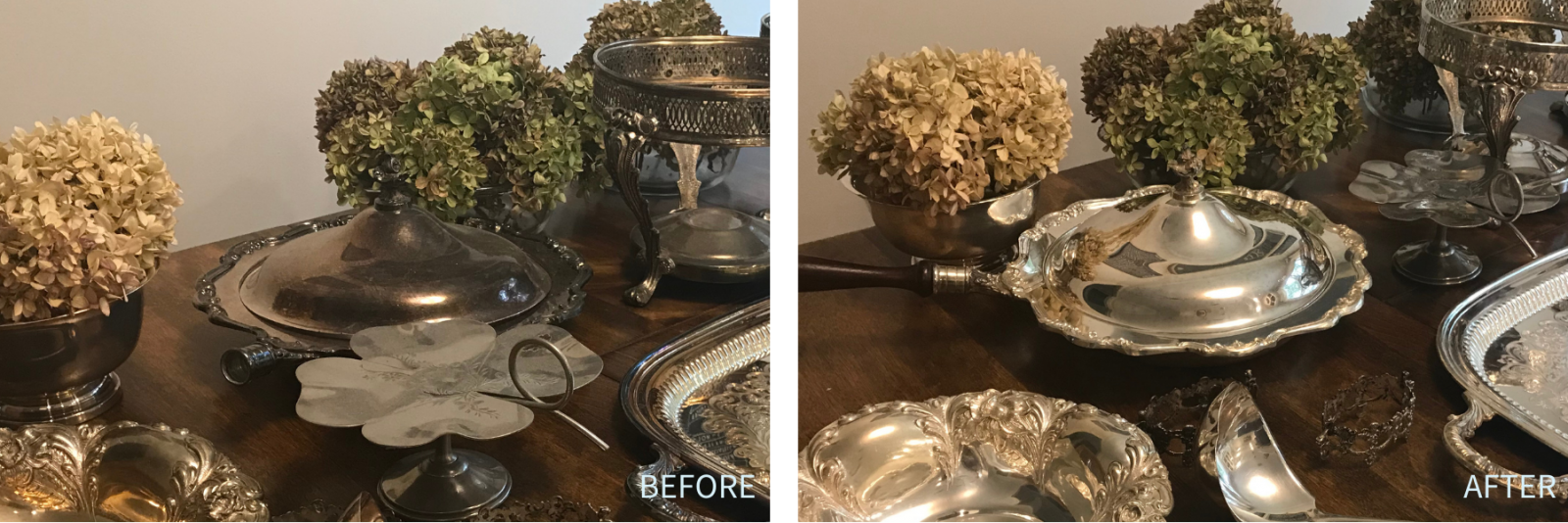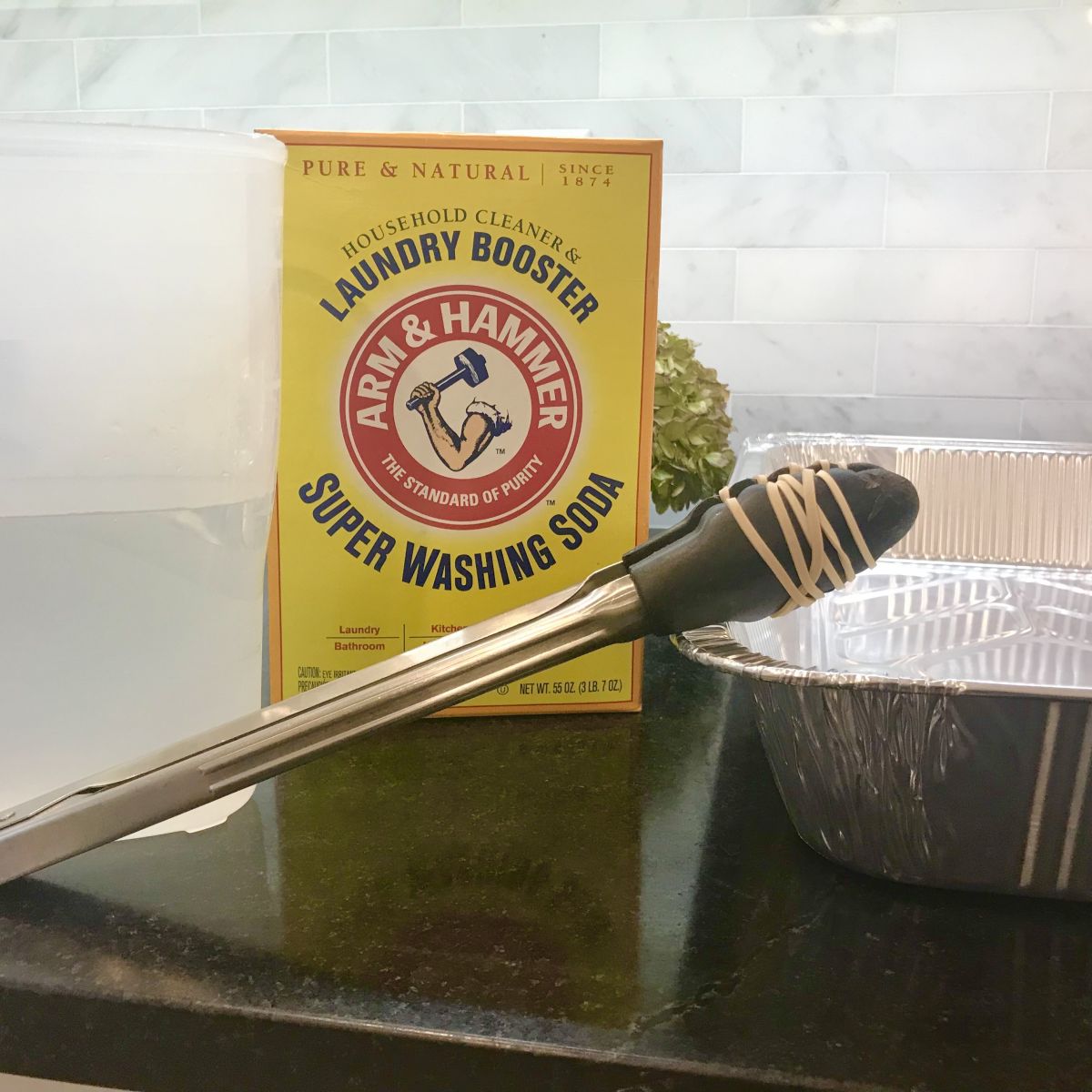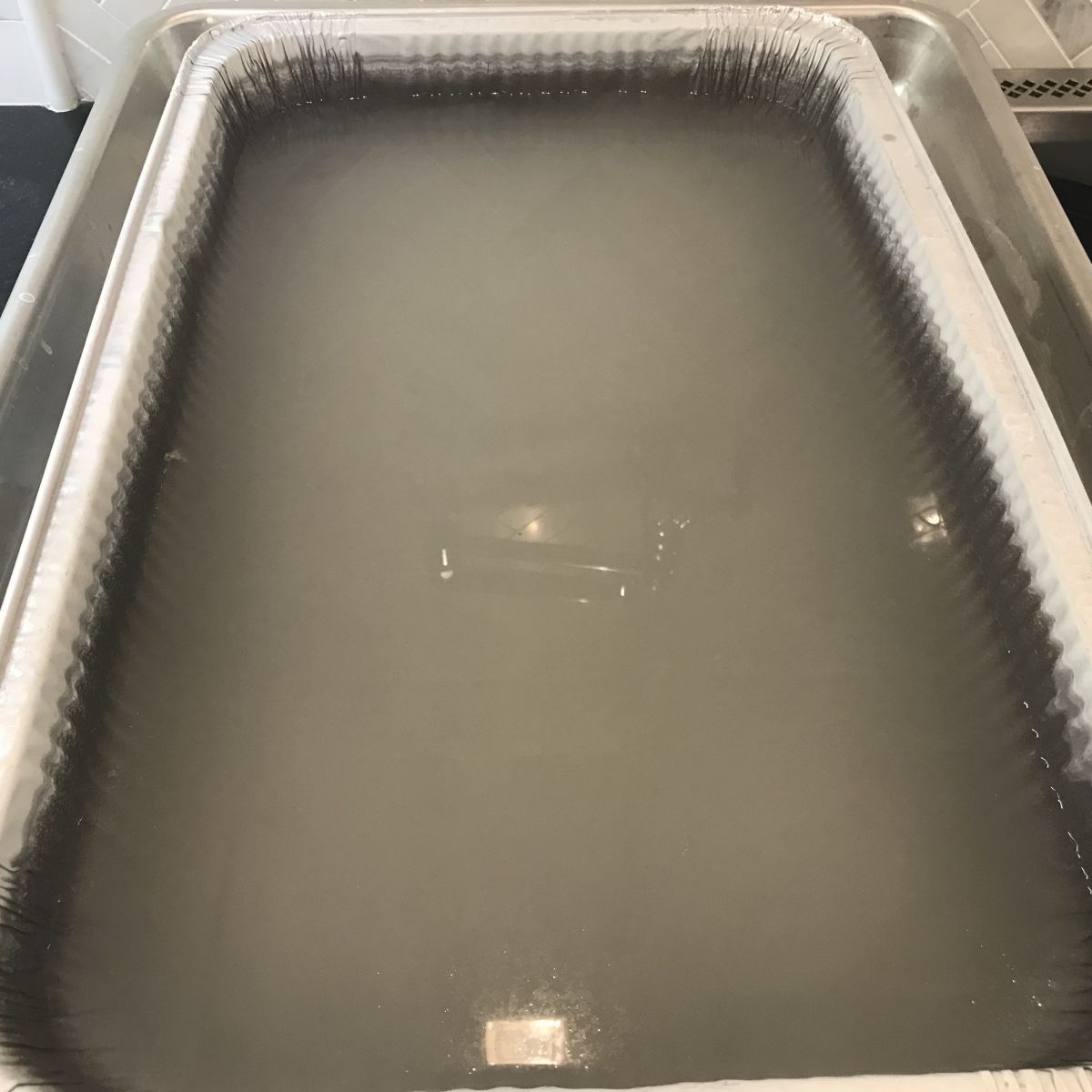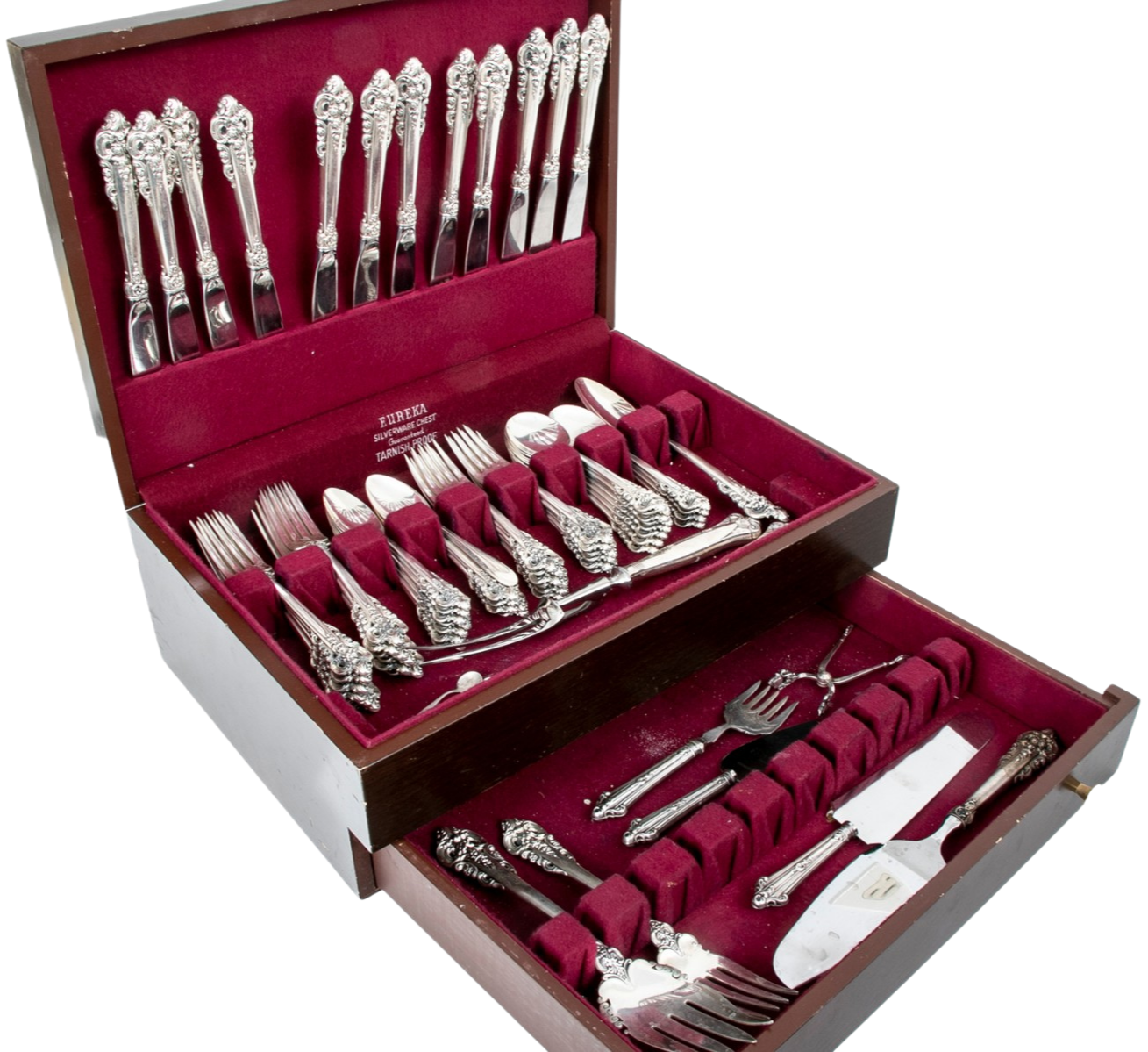Browse
The Best Sterling Silver & Silverplate Cleaning Secret
Tips & Guides | PUBLISHED 11.19.21 | Jennifer Ventresca

From family heirlooms to fabulous secondhand finds, nothing evokes fun yet elegant entertaining like vintage silver serving pieces and vintage silver-plate accessories. What's not to love about the sparkle of fine antique sterling silver and silver-plate pieces when entertaining for the holidays?
Yet, so many people pass on purchasing silver. Why? It's a royal pain to clean, polish and remove tarnish! More importantly, every time you use silver polish on silver or silver-plate, you are inadvertently removing a little layer of silver. That's why traditional polishing is usually a once- or twice-a-year event at maximum.
The once time honored holiday season tradition of spending countless hours polishing your most treasured antique and vintage sterling silver seems pretty odious to most people today -- especially when considering toxic chemicals and potential harm to the finish on silver-plated items. However, the need for tarnish-free serving pieces, bowls, cups, tableware, and other silver or silver-plated items remains.

So what do you do when you have a tarnished antique sterling silver repousse heirloom bowl with a lot of intricate nooks and crannies or a couple of really nice vintage silver plate trays? There must be an easy solution. Some sort of silver cleaning DIY trick. A safe, nasty chemical-free de-tarnishing hack.
(This method is particularly helpful on repousse, filigree, and very detailed antique silverware pieces where traditional polishes either get trapped or are difficult to clean.)
It's one of the best kept secrets. (Yes, there's a bit of science "wizardry" at play, but it's super easy, super safe, and super satisfying.) Take a peek at this brief how-to video.
Supplies:
 You can pretty much find just about everything you need in your home already.
You can pretty much find just about everything you need in your home already.
- • Large disposable aluminum roasting pan
- • Washing soda
- • Water
- • Tongs
- • Soft-lint free dish cloth(s)
- • Pot holders
- • Stove or heating element
|
|
Optional: oversized sheet tray (see hints/tips below)
|
|
Directions:
1. Quick Set-up. Place your disposable pan on your stovetop. Fill with water, leaving room for displacement. Sprinkle in the washing soda.
I've never measured. I just sort of eyeball a reasonable amount. If the tarnish doesn't seem to dissolve once I start soaking silver, sprinkle in some more.
2. Heat. Heat the water to steaming (no need to boil).
3. Soak. Carefully place your silver and/or silver-plate into the pan. If you're working with an item that is too large to submerge all at once, work in sections. Just make sure that those sections are contacting the aluminum under the water/soda solution which creates a natural chemical reaction in a "conductive bath."
4. Remove from Bath. When you're satisfied with the tarnish removal, carefully use the tongs and/or pot holder to remove the item from the solution. Be careful ... the metal may be hot to the touch.
5. Rinse Clean. Rinse the item really well under warm tap water. You can use a soft sponge or a soft cloth in the process. Be sure to not use anything abrasive which may scratch the surface.
6. Gently Buff. Buff dry with a soft, lint-free cloth (microfiber works well, as do soft bar towels).
7. Enjoy Success. Enjoy your beautiful, sparkly silver and silver-plate collection!
|
|
Hints/Tips:
I use an oversized sheet tray pan under the disposable aluminum pan. Because I have a very strong gas range, the sheet pan provides more even heating and protection for the disposable pan (which covers two different burners). It also provides extra support for the aluminum pan above the burners.
The washing soda soak will leave a white residue on the silver and needs to be well-rinsed after de-tarnishing. I find that using a very soft, lint-free cloth and warm tap water work really well. Be sure to use a gentle, soft cloth for rinsing. You don't want to scratch your sparkly, like new silver and silver-plated items.
I personally cover my tongs with some rubber bands and use them sparingly. The bands provide better grip for handling any hot and sometimes wet/slippery silver pieces. (Be mindful that rubber actually contains sulfur which can hasten tarnishing of silver. Since the silver will be rinsed after the soak and the contact with the silver is only in removing the silver from the pan while it's hot, I haven't seen any adverse affects.)
If you can't find washing soda (typically in the laundry aisle of your grocery store), you can substitute with a mixture of baking soda and salt. I've done it it the past, but have had varied success. I've consistently found that washing soda is much more effective.
What is washing soda and how is it different from baking soda? Washing soda is also known as "soda ash." The difference between washing soda and baking soda is simply carbon dioxide and water. However, washing soda, while natural, is not edible. Washing soda should not be confused with Borax or other "laundry boosters."
Remember, the silver needs to make contact with the aluminum under the water bath. It won't work if contact isn't made with the aluminum under the water.
Do not scrub your precious metal with washing soda. It will scratch delicate surfaces. That's why we dissolve it in the steaming water and soak the silver in it.

Do not use an aluminum pan you care about -- they'll be ruined. Disposable is best. I don't know of any way to remove the tarnish stains from the aluminum so don't use your good pans for this.
Wait for the steamy waste water to cool before attempting to move the pan -- you don't want to get burned by hot, sloshing water. The disposable pan can be placed in your recycling with your other aluminum recyclables.
|
|
Storing Silver & Minimizing Future Tarnish

Air is the enemy of high quality silver and prolonged exposure to air will speed-up the tarnishing of your silver and silver-plate. Unless you plan to display your silver collection, it's a good idea to store your items in soft cloth such as velvet or flannel designed for silver storage.
That's why many sterling silver flatware and fine silver pieces are purchased with velvet bags or in velvet-lined cases. Many quality silverplate flatware sets also come with cases or chests. A china cabinet or drawer lined with velvet is also a great option.
If you use tissue paper, make sure that is acid-free, archival quality so it doesn't chemically react and corrode your items.
Make sure your storage area is not in a high heat or high humidity area (unconditioned basements or attics).
Avoid storing your silver in newspaper. Acids used in the inks and found in the paper can corrode your silver / silver-plated items.
Avoid storing your silver in plastic. Plastic might trap humidity and/or moisture and can lead to pitting (tiny black spots on the surface which cannot be polished away.
The oils and acids on your skin can lead to pitting on silver if it's not cleaned promptly. Once polished and ready for storage, avoid touching your silver with your bare hands. Use gloves and/or a cloth over your hands when handling.
This trick is not advisable for silver items that have fabric or other substances attached (i.e., fabric-backed frames, candlesticks with felt/velvet base liner, etc.).
|
|
If this de-tarnishing trick tempts you to buy sterling silver and silver-plate be sure to consider vintage and antique silver. You won't be disappointed with starting your new or expanding your existing collection!
Do you have a favorite silver polishing hack or tip? We'd love to hear from you.
Keywords: silver, sterling silver, silver-plate, silverplate, silver plate, vintage silver, antique silver, flatware, silver polish, polishing hack









